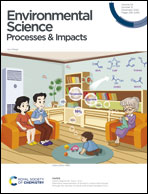Fecal pollution source characterization in the surface waters of recharge and contributing zones of a karst aquifer using general and host-associated fecal genetic markers†
Abstract
Fecal pollution of surface waters in the karst-dominated Edwards aquifer is a serious concern as contaminated waters can rapidly transmit to groundwaters, which are used for domestic purposes. Although microbial source tracking (MST) detects sources of fecal pollution, integrating data related to environmental processes (precipitation) and land management practices (septic tanks) with MST can provide better understanding of fecal contamination fluxes to implement effective mitigation strategies. Here, we investigated fecal sources and their spatial origins at recharge and contributing zones of the Edwards aquifer and identified their relationship with nutrients in different environmental/land-use conditions. During March 2019 to March 2020, water samples (n = 295) were collected biweekly from 11 sampling sites across four creeks and analyzed for six physico-chemical parameters and ten fecal indicator bacteria (FIB) and MST-based qPCR assays targeting general (E. coli, Enterococcus, and universal Bacteroidales), human (BacHum and HF183), ruminant (Rum2Bac), cattle (BacCow), canine (BacCan), and avian (Chicken/Duck-Bac and GFD) fecal markers. Among physico-chemical parameters, nitrate–N (NO3–N) concentrations at several sites were higher than estimated national background concentrations for streams. General fecal markers were detected in the majority of water samples, and among host-associated MST markers, GFD, BacCow, and Rum2Bac were more frequently detected than BacCan, BacHum, and HF183, indicating avian and ruminant fecal contamination is a major concern. Cluster analysis results indicated that sampling sites clustered based on precipitation and septic tank density showed significant correlation (p < 0.05) between nutrients and FIB/MST markers, indicating these factors are influencing the spatial and temporal variations of fecal sources. Overall, results emphasize that integration of environmental/land-use data with MST is crucial for a better understanding of nutrient loading and fecal contamination.



 Please wait while we load your content...
Please wait while we load your content...